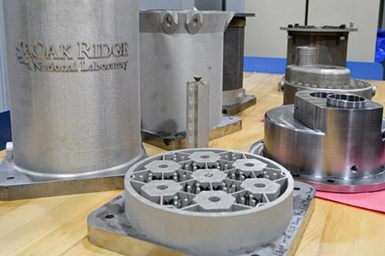Siemens Partners with ORNL on Additive Manufacturing Research
Joint project focuses on U.S. manufacturing innovation to include additive manufacturing, workforce training and decarbonization.
Share
Read Next

3D Printed parts from Oak Ridge National Laboratory. Photo Credit: ORNL
Siemens says it is engaging in early-stage research and development projects with multiple partners, including the Oak Ridge National Laboratory (ORNL) to advance additive manufacturing (AM).
The Department of Energy’s (DOE) Manufacturing Demonstration Facility (MDF) at ORNL is known as a pioneering institution focusing on manufacturing analysis and simulation, materials development, large-scale metal systems, robotics and automation.
The company says the collaboration between Siemens and ORNL on multiple DOE-funded projects has enabled the cooperative investigation of multiple methods of advanced manufacturing and materials solutions.
“The joint collaborative research done at MDF to address industrial problems demonstrates the success of the DOE’s MDF model and clearly shows the need for a path to industrialization through similar hubs in industry focusing on higher technology readiness levels,” says Dr. Anand Kulkarni, senior principal key expert at Siemens Technology.”
Siemens’ recent launch of its Charlotte Advanced Technology Collaboration Hub (CATCH) facility in North Carolina was designed to fill this void and help customers accelerate their plans for the industrialization of AM.
The joint research project with ORNL, MDF and Siemens aims to help advance and revitalize the U.S. manufacturing sector. “We recognize that our DOE-funded research is often best leveraged through regional and national collaborations like CATCH and the MDF, helping to advance additive manufacturing technology, drive workforce development and create a more efficient and decarbonized manufacturing base,” says Bill Peter, ORNL advanced manufacturing program manager.
CATCH is a strategic research and development hub spearheaded by Siemens Digital Industries, Siemens Technology and Siemens Energy. Siemens says it will use this space to collaborate with key machine builders (OEMs), end-users and U.S. national laboratories to ensure the successful industrialization of AM.
Over the years, Siemens says it has focused on bringing emerging technologies to the point of industry acceptance and standardization, including next-generation computer numerical controls to industrial manufacturing software and digitalization.
“We are excited to launch this new additive manufacturing hub and begin inviting customers in to collaborate and find ways to accelerate the industrialization of this technology using our machine-agnostic solutions,” says Tim Bell, AM business manager, Siemens Digital Industries. “The benefits of additive manufacturing are clear — from faster time-to-market to better design through digital prototypes, to localized manufacturing helping to reduce supply chain constraints. We believe that future of manufacturing is additive.”
Related Content
-
Think Tank, US Navy Announce Plans for Developing Guam Additive Materials and Manufacturing Accelerator
Nonprofit organization ASTRO America will manage staging and deployment of 3D Printing Technology and Workforce Education Center on Guam to diversify the island’s economy and support Indo-Pacific submarine industrial base needs.
-
AddUp Receives ASTM Additive Manufacturing Safety Certification
AddUp Inc. announces that it has received the ASTM Additive Manufacturing Safety (AMS) Certification, becoming the first OEM in the AM industry to achieve this significant milestone.
-
4 Ways the Education and Training Challenge Is Different for Additive Manufacturing
The advance of additive manufacturing means we need more professionals educated in AM technology.










